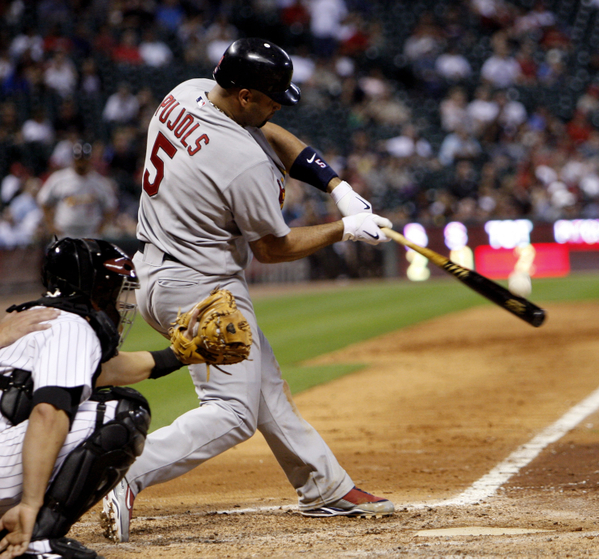
If you think of the great power hitters of all time—Babe Ruth, Lou Gehrig, Willie Mays, Hank Aaron—the names that come to mind were more than power hitters, since they were all around fantastic batters. The traditional definition of a slugger did not necessarily include hitting home runs, but rather, hitting the ball solidly and often. In the right circumstances, a hard grounder up the middle was just as exciting as a 450 foot bomb.
Back in the day, in order to be viewed as a great ballplayer, a slugger needed to be able to perform well in all other aspects of the game. The Bambino’s career batting average is .342, and Gehrig’s is .340, both higher than contact hitters such as Tony Gwynn and Rod Carew. Hank Aaron’s career runs scored is tied for 4th all time, proving that he was an excellent base-runner. These are just a few examples.
However, nowadays, most home run hitters focus only on hitting home runs, disregarding all other components of the game. This phenomenon can be attributed to many causes—the Designated Hitter, the failure of fans to appreciate all facets of the game, and the popularity of the home run. In any rate, the emergence of these new power hitters is hurting their teams and the game itself.
The first modern power hitter seems to be Bobby Bonds. Though Bonds did swipe bases effectively throughout his career, his strikeout totals were unheard of for his time. His career totals in batting average and on base percentage are pedestrian, and his slugging isn’t overwhelming either. The number that jumps off the page is Bonds’s strikeout total, 1757 K’s in only 14 seasons. Per 162 games, he averaged 154 K’s. Because he was respected as a three-time all-star and a solid ballplayer despite his strikeout numbers, Bonds lead the way for the new style of power hitters.
Another early example is Reggie Jackson, the strikeout king. His postseason heroics cemented him as a legend, and the guy knew how to hit home runs. But, that’s just about all he knew how to do. That, and strike out. Mr. October never drove in that many runs, or stole that many bases, or drew that many walks. His only proficiencies were hitting the long ball and “K-ing.” Yet, because of those heroics, and the fact that he played the prime of his career in the Big Apple, Jackson is considered one of the finest hitters of his day, a claim that simply cannot be supported.
I believe that these two players changed the game forever. A lot of my friends criticize baseball because many of its stars seem to be out of shape. Most baseball players in the game today are in good shape, but the ones whose fitness is suspect stand out: David Ortiz, Prince Fielder, Paul Konerko, Ryan Howard, Adam Dunn, Jim Thome, and more. Some of these guys are “large,” and some of them just can’t run. Regardless, to play in the Major Leagues, a player should be able to be successful in more than one facet of the game in order to help their team.
Most power hitters of today strike out in bunches, even infielders like Alex Rodriguez. Take a look at the stats of Adam Dunn or Ryan Howard, and you’ll notice a pattern: low to average batting averages, lots of strikeouts, no stolen bases, and lots of home runs. This is a common model of the average power hitter of the 2000’s.
RYAN HOWARD
ADAM DUNN
ALBERT PUJOLS
VLADIMIR GUERRERO
One of Bill James’s most interesting stats is the “similarity score.” According to baseball-reference.com, “To compare one player to another, start at 1000 points and then you subtract points based on the statistical differences of each player.” Dunn and Howard over the years have been scored similar to players like Richie Sexson, Norm Cash, and Daryl Strawberry, none of which are Hall-of-Fame quality ballplayers.
While most power hitters nowadays are “one-dimensional,” there are a few exceptions: Albert Pujols and Vladimir Guerrero are versatile ballplayers with good power as well as plate discipline. Using similarity scores, the two players have been compared to Joe DiMaggio, Jimmie Foxx, Willie Mays, and Duke Snider, all of whom are legends of their time. Despite this, most power hitters of the day can’t run, can’t hit for average and strike out far too frequently.
In many home run hitters’ contracts, there is a clause stating that they get rewarded for hitting a certain amount of home runs. A possible solution to the “one-dimensional” problem is rewarding a player not only for hitting homers, but striking out less, or stealing bases, or hitting for a high batting average. The home run is an important part of the game, but it shouldn’t be rewarded more than any other part.
Overall, power hitters today specialize in just hitting homers, which has changed the game for the worse. Many of them aren’t athletic enough to even play a full season, and baseball gets a lot of negative commentary because of it. I don’t know if the game can ever be the same again, but I hope it will change back to its true self eventually.









